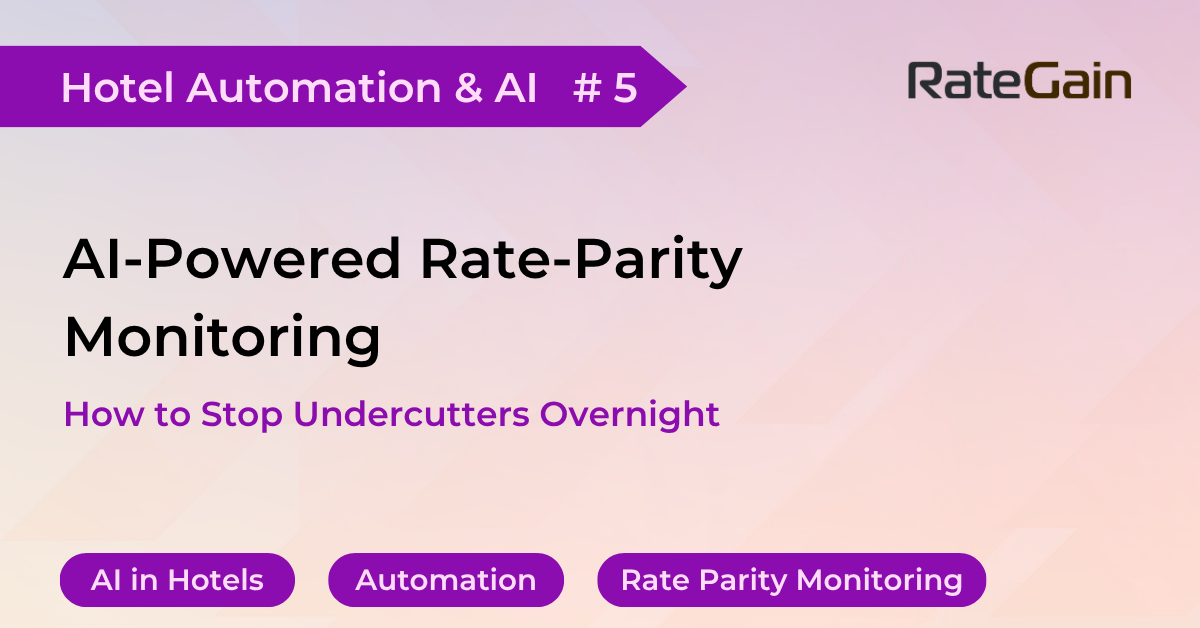Online shoppers have become professional price detectives. The moment they spot your Deluxe King room for USD 25 less on a fringe OTA, they question every price you publish, and every channel partner you use. Today, the stakes are even higher because guests can surface real-time meta-search grids in one click, then broadcast every rate discrepancy on TikTok, X, or WhatsApp groups.
Statistic check: The latest State of Distribution 2025 survey of 700 brands and 21,000 properties lays the operational reality bare:
- Rate parity monitoring is the No. 1 manual task for 83.6 percent of hotels worldwide.
- The load is universal: large chains 63 percent, mid-sized chains 63 percent, and independents 91 percent all rank parity policing first.
The State of Distribution 2025, produced jointly by HEDNA, the NYU SPS Tisch Center, and RateGain, aggregates feedback from 700‑plus brands across 21,000 properties. Their consensus is clear: parity leaks cost more in lost bookings than they do in commissions.
Every staff hour spent chasing leaks is an hour lost to forecasting, merchandising, or guest care.
This post distills those findings into a playbook that explains why parity still matters, how AI crawlers catch undercutters in minutes, and how to escalate fixes without burning staff hours.
Why Parity Still Pays
Rate parity is more than a contract clause; it underpins revenue integrity, channel economics, and corporate credibility. Below, we translate those broad concepts into tangible dollars and risk-mitigation wins.
1. Margin preservation
A 3 percent gap on a USD 180 ADR erodes USD 5.40 per room, per night. Multiply that by 70 keys at a 70 percent annual occupancy rate, and the “small” leak quietly reaches almost USD 100,000 per year. That is money you have already generated—then surrendered.
2. Channel discipline
OTAs weaponize cheaper public rates to hijack bookings that would have flowed through your direct site, inflating commission costs by up to 18 percent. Worse, shoppers conditioned to “OTA first” rarely return to brand.com, turning a one-time breach into a lifetime habit.
3. Corporate credibility
Travel-management companies and procurement teams pore over parity clauses during RFP season. Persistent undercuts can trigger penalty fees, jeopardize long-term contracts, or remove your hotel from preferred lists altogether. Protecting parity, therefore, is protecting base business.
How Big Is the Manual Burden?
To justify budget, you must first size the pain. When 700 brands ranked their weekly time sinks in State of Distribution 2025, rate parity monitoring crushed every other duty—even the perennial headache of report building.
| Segment | Share Marking Rate Parity Monitoring #1 | Runner-Up Task, Share | Gap vs. Runner-Up |
|---|---|---|---|
| All Hotels | 83.6 % | Improving direct bookings: 50.7 % | +32.9 pts |
| Large Global Hotel Chains | 63 % | Generating performance reports: 46 % | +17 pts |
| Mid-sized Regional Hotel Chains | 63 % | Improving direct bookings: 50 % | +13 pts |
| Independent Hotels | 91% | Guest-data reporting: 57 % | +34 pts |
Parity drains more labor than reporting, availability sync, or content upkeep, making automation the rare investment that unites revenue, distribution, and operations teams.
AI-Powered Monitoring: From Scrape to Score
Traditional parity checks involve analysts opening half a dozen OTAs, running test dates, and screenshotting gaps—a ritual that catches issues hours (or days) late. Machine-learning platforms collapse that lag to minutes. Here is the four-stage pipeline.
1. Harvest at web scale
Headless Chromium browsers, routed through residential proxies, scrape millions of rate quotes per hour without tripping bot walls or rate limits. The crawler mimics real guests, gathering HTML, JSON, and API payloads for both public and member-only prices.
2. Normalize the chaos
Room codes are a distribution Tower of Babel. NLP models, fine-tuned on hospitality taxonomies, translate “DLX K,” “Deluxe King Garden,” and “King DLX” into one canonical SKU. They also standardize currency, tax structures, and inclusive / exclusive pricing flags so every rate sits in a clean, comparable table.
3. Score what matters
A gradient-boost ensemble weighs four vectors—price delta, stay-date lead time, room popularity, and partner history—to assign a Severity Score (0–100). A five-dollar gap for tonight on a high-volume room might score 90; a two-dollar gap six months out might score 15.
4. Alert in real time
Only high-severity breaches trigger human attention. Alerts land in Slack, Microsoft Teams, or your ticketing tool within 15 minutes of detection—down from the eight-hour average for manual spot checks.
Escalation Workflow: Four Steps to Closure
Automation without action is noise. The most successful hotels attach a clear, time-boxed response ladder to every alert.
- Validate (~5 min): A quick look confirms the gap is genuine—no currency mismap or tax bundle quirk. This step protects partner relationships from false alarms.
- Notify partner (~15 min) A templated email, auto-filled with date, room, parity delta, and screenshot evidence, gives the OTA or wholesaler 24 hours to correct. Empathy plus data keeps conversations civil and fast.
- Apply guardrails (24 hours): If the partner misses the fix window, the channel manager auto-closes the rogue rate plan or applies a dynamic markup, sealing the leak while preserving availability.
- Review & learn (weekly): A governance dashboard logs the source, duration, and revenue impact of every breach, feeding contract negotiations, allotment caps, and annual rate-loading policies.
Hotels running this cycle report a significant reduction in repeat breaches, plus sharper leverage in partner renewals.
90-Day Rollout Roadmap
Automation does not require a seven-figure data lake. A phased sprint limits risk and surfaces quick wins.
| Day | Milestone | Success Metric | Sample Tooling |
|---|---|---|---|
| 15 | Inventory every live rate URL, map to SKUs. | 100 % coverage | Channel-manager export, Excel audit |
| 30 | Deploy crawler in “monitor-only” mode on top five markets. | ≥ 90 % crawl success | Playwright / Puppeteer containers |
| 45 | Pipe alerts to Slack or Teams; tag by severity. | < 5 min alert latency | Webhooks, serverless queue |
| 60 | Auto-generate partner notices with screenshots. | All breaches notified ≤ 30 min | CRM merge fields |
| 90 | Enable auto-closure or markup for repeat offenders. | 50 % shorter breach duration | Channel-manager API endpoints |
Schedule a 30-minute retrospective each Friday. Cross-functional ownership (revenue, distribution, legal) cements adoption and fuels incremental improvements.
Next Step: Benchmark Your Risk
Curious how your property stacks up? Download The State of Distribution 2025 for parity-breach frequency, average delta size, and annualized revenue loss by chain scale, region, and channel mix. Learn how peers clawed back six-figure margin leaks in less than a year—proof that automated rate parity monitoring is mission-critical, not “nice to have.”
 Deutsch
Deutsch Português
Português Italiano
Italiano Espanol
Espanol čeština
čeština ไทย
ไทย العربية
العربية Français
Français



